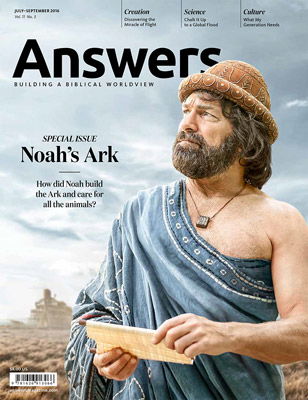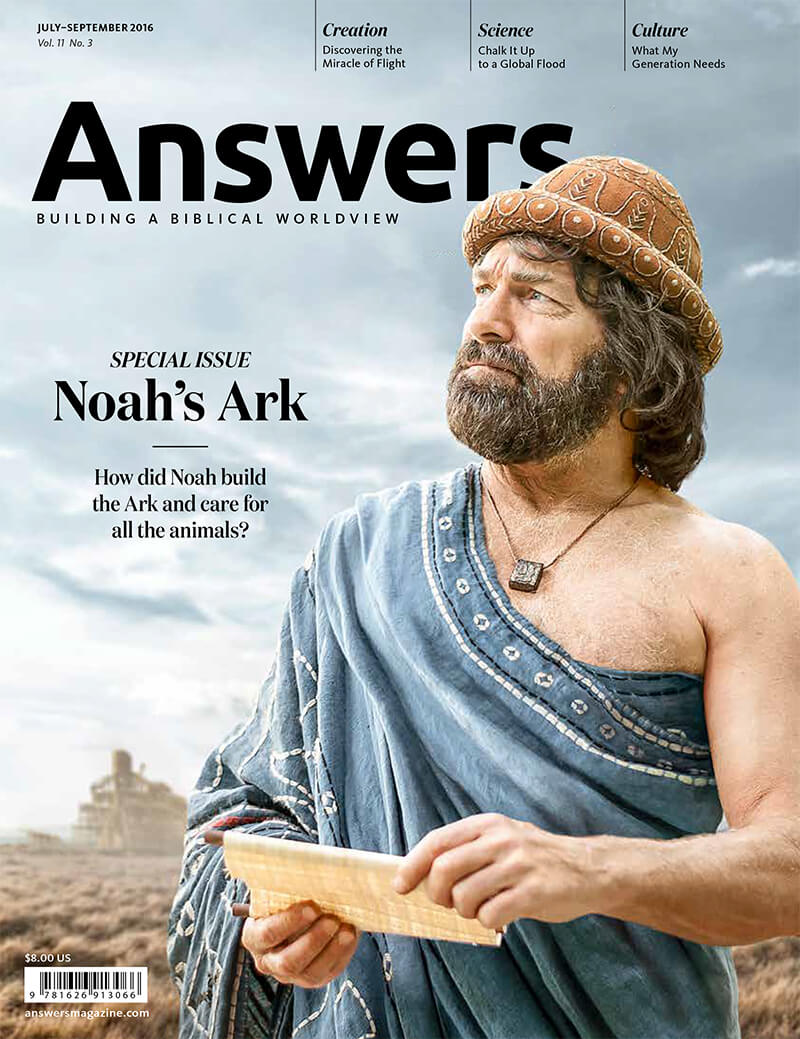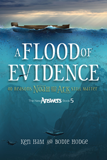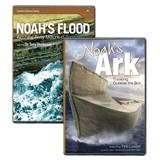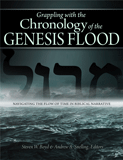
Fantastic Voyage: How Could Noah Care for the Animals?
How Could Noah Care for the Animals?
Even if Noah could build a wooden Ark strong enough to survive a yearlong Flood, how could he house and feed all those animals? Imagine the challenges of space, food storage, waste removal, ventilation, and fresh water. It sounds too fantastic to believe! Or is it?
Even if Noah could build a wooden Ark strong enough to survive a yearlong Flood, how could he house and feed all those animals? Imagine the challenges of space, food storage, waste removal, ventilation, and fresh water. It sounds too fantastic to believe! Or is it?
It’s difficult to think of Julius Caesar and other famous historical figures as real people, especially since we never lived in ancient Rome or ate blood pudding and Julian stew at the emperor’s table. We know they were real folks, but we never experienced the things they saw and touched every day.
This is no less true of Bible characters like Noah. Many people think of him as a great example of a faithful man—and he certainly was that (Hebrews 11:7). But he was a living, breathing ancestor on your and my family trees. Like the rest of us, he had his fair share of joy and pain, failures and victories, times of ease and challenges. God tells us more about him than any other non-Jew. The more we think about his impossible undertaking, the more God can use it to inspire us to imitate Noah’s faithfulness.
You think you face challenges? Noah had to engineer the biggest wooden ship ever built. But that was just the beginning. He had to care for every kind of air-breathing land animal that God had made. Imagine. Modern zookeepers often find it challenging to keep a single wild species healthy, even after years of study. Noah, in contrast, had to meet the peculiar needs of every kind of wild creature. That includes not only the ancestors of modern bears and anteaters but tyrannosaurs and pterosaurs.
Modern skeptics scoff at the possibility that a single family could coordinate such a huge undertaking. Just think about some of the difficulties:
How could you store enough food for several thousand animals over a year?
How could you feed so many animals every day?
Where would you put all their waste?
How could you replenish their clean water?
Put yourself in Noah’s shoes. He had a challenging job ahead of him. God had given him broad instructions for the Ark’s building materials and dimensions, but what about the details on the animals? Noah was hundreds of years old when God spoke to him, and he had learned enough to know that this project would demand more wisdom than any one man possessed.
God told him that He would send him every kind of animal, but what would be the total number? The whole world would be destroyed with water, but how long would the Flood last? Noah needed answers to all these questions to build enough cages and store enough food. God gave him the broad outline, but Noah was responsible to research, organize, and plan. It was just the same as it’s always been. God gives us a job to do, but every believer must prayerfully work out the details.
Cozy Quarters
First, how do you keep animals safe for such an extended period of time? To make matters worse, a flood of this scale would be a violent event, with raging winds and pounding waves jostling the ship.
We can’t go back to Noah’s actual home to know exactly how he solved these problems. But we know enough from the history of animal care—and modern husbandry—to imagine the most likely solutions that a reasonable man with a good knowledge of animal behavior could implement in any era of history.
For example, providing animals with spacious accommodations may seem ideal. But in reality, animals under stress often feel much safer in tighter quarters, and they even seek out little “nests.” So providing small, fairly dark spaces, such as cages, would help them feel more secure. Also, animals do better when they are grouped with other members of their kind. So it made sense for Noah to keep many of the animals in pairs.
Many larger animals may need to get out occasionally and stretch. Noah could have come up with some practical solutions that wouldn’t require too much extra space. Perhaps larger animals could be channeled into more open areas via a system of gates, allowing them to exercise on a rotation schedule. Just avoid getting into the pens with the larger ones because moving ships move animals!
Wood is adequate building material for most cages, but what about the cages for those animals that gnaw wood? Smaller cage bars could be made of bamboo because it is a very hard material and resists chewing. An added benefit of bamboo is that it grows quickly. Perhaps Noah could grow fresh batches every spring while he was building the Ark.
The dim lighting in the Ark would have a positive impact on many reptiles and amphibians, making them largely inactive. Inactive crocodiles, for instance, are known to last up to three years without a meal. But what about the rest of the animals that would still be active and eating? God specifically mentioned that Noah needed to gather up food for the floating menagerie.
Plenty of Room
If containers were stacked efficiently, the Ark could easily store food and water for thousands of animals. Larger animals could live in central pens, while reptiles, birds, and smaller mammals could be stacked in cages on the sides and bottom deck. (This is just one possible layout.)

Click to view larger image.
The Galley
Ah, that’s right: food. Over the course of a year, these several thousand animals will consume a few hundred tons of it. Now that’s a lot of kibble!
Many of today’s animals have very specialized diets because they’ve adapted to nearly every niche on the planet. The animals that God sent Noah, in contrast, likely weren’t the most specialized species within a created kind. In fact, most animals can eat almost anything nutritious (rather than starve) if they don’t have a choice.
So Noah had to identify the food types that would meet each animal’s basic survival needs, at least short-term. He could then divide up the animals into zones on the Ark near their primary food sources. Koalas and emus would be next to the dried fruits; pigs and kangaroos next to the grain.
This would make the process of feeding more efficient. He needed to identify foods that had a long shelf life, such as dried plant leaves, grasses, and seeds. Fresh leaves and grasses could be made into a mash and compressed into pellets, compacting a lot of nutrients into a small space like energy bars. Any farmer would know to store the food pellets in waterproof containers, such as earthen vessels.
Fruits preserve well in honey, jams, jellies, and syrups. Certain tubers and gourds even remain fresh for up to a year, if hung in the air. Dried fruits are easier to keep, though.
Dried vegetation is sufficient for the vast majority of herbivores, but if fresh vegetation was needed, whether for food or medical purposes, Noah had to find or cultivate varieties that grew well in low-light conditions. As much as possible, he needed to provide varied food types because animals with more balanced diets are usually healthier.
Most animals consume plants, but what about ones that may have switched entirely to meat—as have modern snakes and cats? Would Noah want to store live animals on board as food? It certainly could be done. For instance, seafarers in the 1600s and 1700s frequently brought giant tortoises on their ships as a fresh meat source. Tortoises are hardy and can sometimes stay alive for over a year without food. Alternatively, meat can be preserved through drying, pickling, salting, or smoking.
In many cases, meat-eaters will switch to plant material or insects when meat is unavailable. Insects would be easy to breed in fruits, grains, meat, and manure. Manure was certainly available in abundance—waste not, want not!
Whatʼs That Smell?
And speaking of animal waste, what is the best way to deal with the Ark’s leading export? Though some of the solid waste could become insect food, the majority—say, a few tons per day—would likely require disposal or neutralization. No big deal, right? Obviously, Noah’s crew could jettison the waste from the Ark either manually or with simple animal-powered systems. On the other hand, food containers could be refilled with solid waste as they were emptied. Alternatively, worms could break down the solid waste into a nutrient-rich soil—a process called vermicomposting. Choices, choices, and every one of them viable!
Noah could have built slatted or grooved floors beneath some of the cages, perhaps with gutters, to help automate the process of waste collection. Bamboo is once again a practical choice because it resists urine’s corrosive effects. Bamboo could even be used to pipe away liquid waste.
Methane build up, on the other hand, is not a problem: it’s lighter than air, and the Ark has excellent ventilation up top. Stinky? Yes. Dangerous? No.
Water, Water, Everywhere . . .
How will you provide fresh water for the Ark’s population? Cisterns or other sealed vessels could house several million gallons of water—enough to last a year. However, this solution raises unique difficulties. First, water use is hard to predict. How much will the animals consume in these stressful conditions, and how much waste is likely? How much of the sitting water might get infested with harmful organisms?
A solution is periodic cleanings of the cisterns or the use of water-filtering organisms, such as mussels. But you’d have the laborious task of shifting water between cisterns. Also, there is a risk of the system becoming clogged with the filterers.
An alternative is to collect rainwater from the Ark’s large roof surface. A problem is that the rainfall may have been unreliable later in the Flood sequence. Also, the volcanic eruptions may have contaminated the water, requiring special water treatment—probably impractical given the sheer volume of liquid needed on the Ark.
Perhaps the best solution is a combination of storage and rainwater collection. Bamboo pipes and simple valves could help disperse the water from the cisterns, while Noah could have placed vacuum-fed water containers in most enclosures that would require refilling only from time to time, not daily. Any rainwater collected would possibly still need treatments, such as settling, filtering, and chemical cleansing, but on a more practical scale.
An Empty Tomb
This just scratches the surface of the challenges Noah had to consider. Indeed, the task must have been overwhelming. A skeptic may see the difficulties and dismiss the account as a myth describing a deathtrap that would become a tomb rather than a lifeboat.
But on what does success of a project ultimately hinge? It wasn’t God’s ability to pick a man who was great at planning. It was simply God’s favor to Noah; then Noah feared God and obeyed His commands.
Whether blessings or curses, mercy or judgment, God always keeps His word. Noah accomplished everything God had commanded because Noah knew his Creator had made a promise, and His Creator always keeps His promises. By resting, not in his own faithfulness, but in God’s, Noah knew that God would see him through the Flood—to save both him and his household.
The Ark did more than provide their personal physical salvation, though, didn’t it? Indeed, you and I were preserved on that ship in them. Yes, the skeptic may see the Ark as a hopeless tomb. But in reality it was a temporary tomb from which new life arose.
Efficient Systems
Food & Water
Noah could easily have installed efficient ways to gather fresh rainwater into cisterns below the roof (1) and then distributed the water through bamboo pipes and simple valves to containers in each pen (2).
Waste Removal
To simplify urine removal, it could easily have drained down sloping floors into a system of bamboo pipes (3). Animal-powered pulleys could then dump liquid and solid waste into an empty cavity inside the ship that opened into the ocean (called a moon pool inside modern vessels, 4).
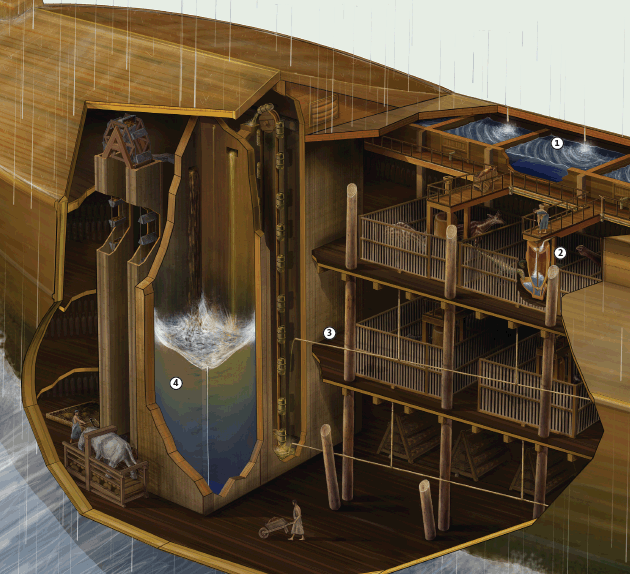
Answers Magazine
July–September 2016
How did Noah build the ark? This issue explains how Noah had technology to build a massive Ark and how eight people could care for so many animals.
Browse IssueRecommended Resources

Answers in Genesis is an apologetics ministry, dedicated to helping Christians defend their faith and proclaim the good news of Jesus Christ.
- Customer Service 800.778.3390
- Available Monday–Friday | 9 AM–5 PM ET
- © 2025 Answers in Genesis


